In The Mood! Had the opportunity to discuss Dungeons and Dragons with my friend Jon again. There was a lot of good stuff tucked into “setting the mood”. We both thought the topic wouldn’t be super deep, but as it turns out there are quite a few things to consider about it. Check out the latest video!
Tag Archives: Dungeons & Dragons
Attack Of Opportunity!
Normally I’d have notes and various preparation bits that I’d share along with a link to the new video, but this is not about me. It was fantastic to hear from these women. Hopefully we’ll have more of this in the future!
Another Attack of Opportunity
Art and it’s influence on Dungeons & Dragons for me – It’s fantastic to sit and talk about all the parts that have kept me on board with this hobby for all these years. You can check out the video here:
My notes on it all ~
Art has always been an important part of the D&D experience. Even from the earliest days when some of the production was created (clearly) using a typewriter and blurry copies there were sketches. I am a super visual person. In fact, the entirety of my day job right now is creating three dimensional representations of building designs. Design, drawing, art, aesthetic considerations are the core of what I do.
I have always been drawn to, and absolutely love the visuals of this amazing and wide ranging fantasy game. It is a constant source of inspiration to me, even now, in my current game and world building. I back very, very few Kickstarter campaigns, but when I saw that there was one about the art of D&D I went as high as I could afford on it right away. It matters that much to me. IF you have the chance, go out and grab a copy or watch via your streaming service the film “Eye of the Beholder – The Art of Dungeons & Dragons”. I Highly recommend this film.
What are my top ten art pieces from D&D? That was both a simple and a massively complex question all in the same breath. I can see them in my head. I remember the feeling when I first saw them. I have many of them collected up in their original book covers, box art, and magazines. I have a handful of prints from conventions that are from product production runs showing the art without the text added in. I’m not a hardcore collector, but I can say without question this art surrounds me almost every day in my home.
The real question is where to start?
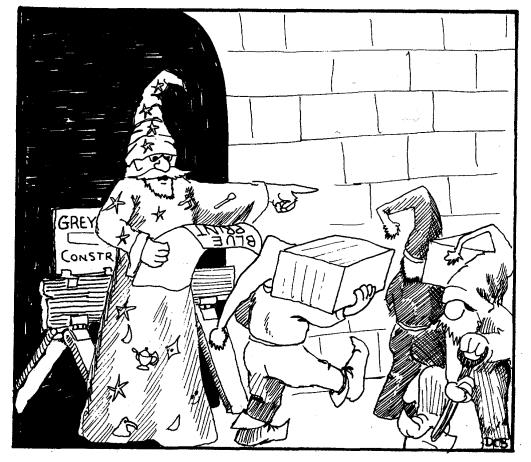
#1 – Sketchy Art. I do not in any way want this to sound like I’m trying to be down on these pictures at all. Quite the opposite. I found them inspirational simply because they looked like they could be achieved to me. One example (there are many) is this cartoon from Dragon Magazine. It’s funny and it’s clearly hand drawn. I looked at pictures like that in my gaming materials and thought, “I can do this too”. So I started drawing and creating trying to match the cool, funny, fantastic pictures I saw in the gaming materials – and even got some published!
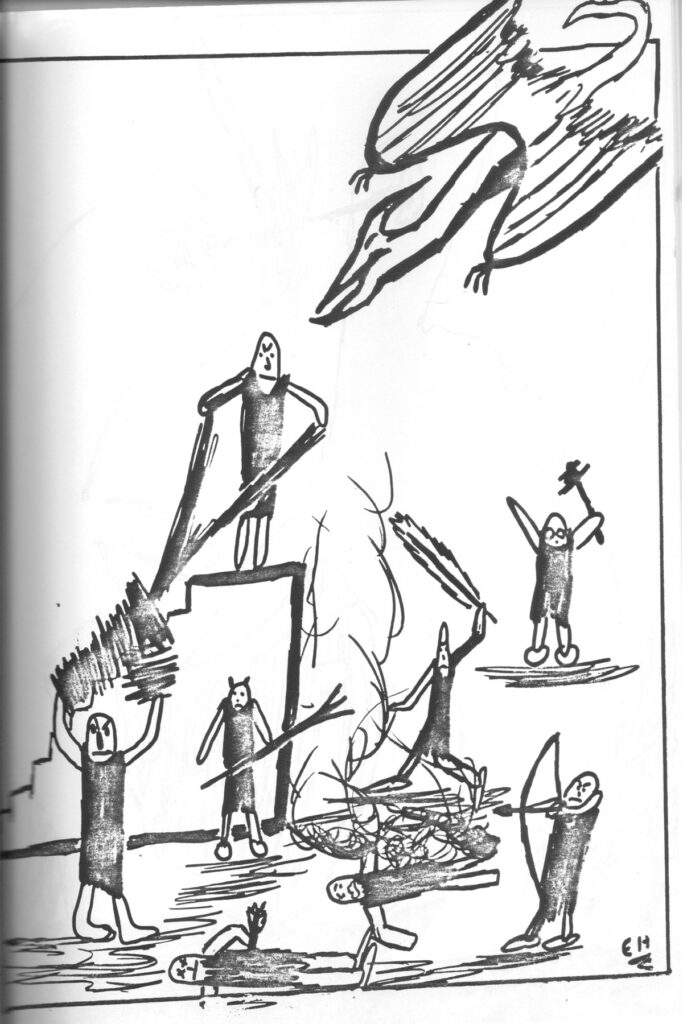
This piece was part of an actual book of cartoons published by my middle school. I think I was 11 at the time it was published. Little did I know how hooked I’d be on that feeling.
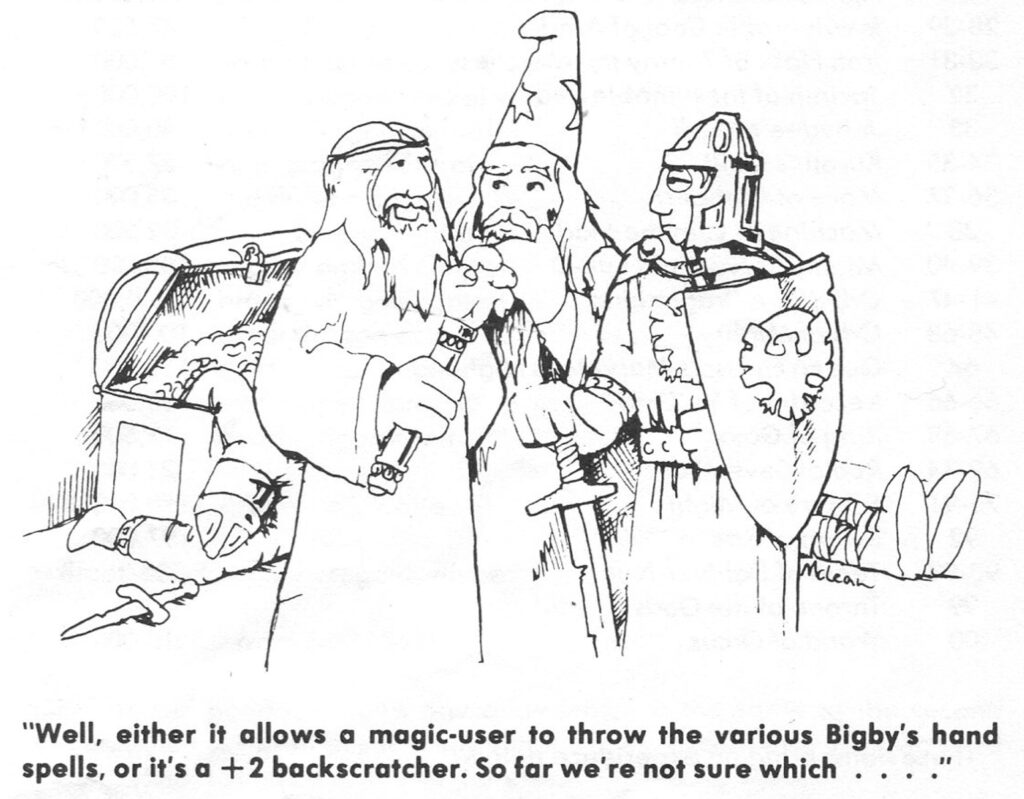
#2 – Cartoons. Particularly in the AD&D 1st edition books. Black and white single line drawings with text below. They were fantasy art AND they cracked me up. Anyone that played then will know them. I can say, “… or it’s a +2 back scratcher” and you’ll know exactly what cartoon I mean.
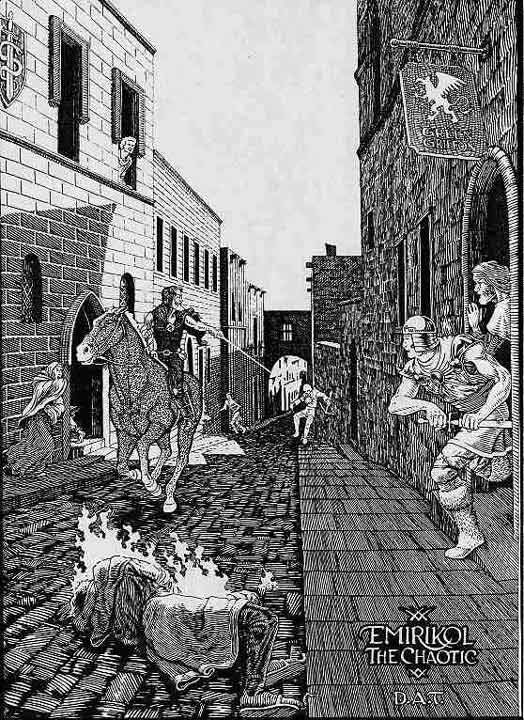
#3 – Emirikol the Chaotic. Staying in 1st edition, in the DMG there were full and half page art pieces that were just fantastic. One of my favorites was this crazy wizard riding through town just blasting people. It was a snapshot of action. It was proof positive that not everyone was a good guy. It was how you set up an adventure with a single idea and give it location. It’s right there! Start at the Green Griffon and go from there! Love it.
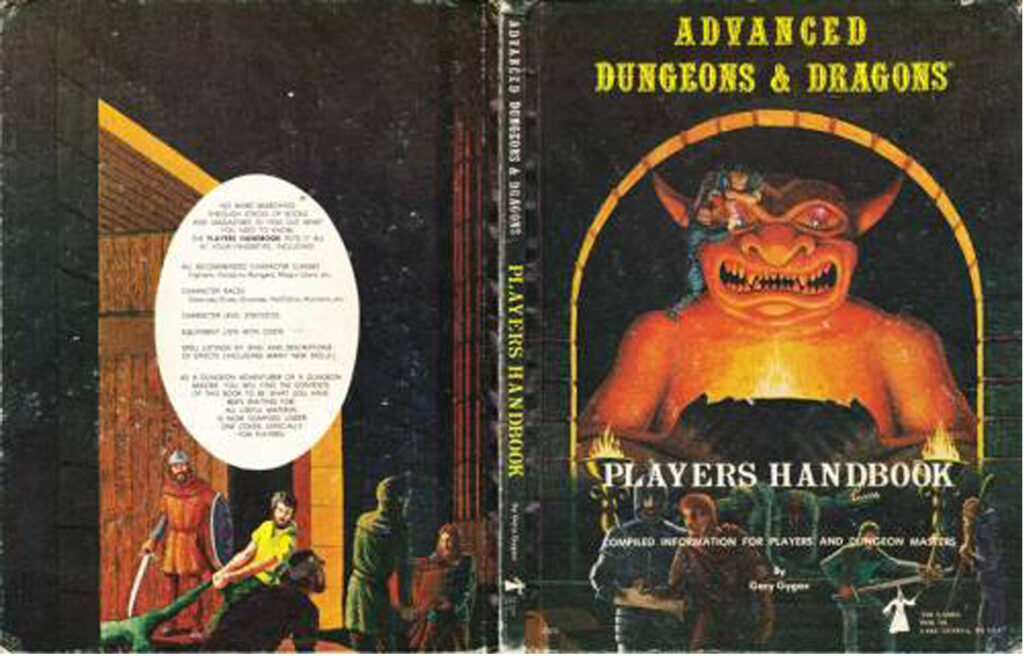
#4 – The cover art for the AD&D 1st Ed. PHB. It told a story. It didn’t stop with a single image, it wrapped around to the back of the book too. There were monsters and maps and gems. There was a ton of ways you could dig into this picture and see what was going on here. An absolute classic.
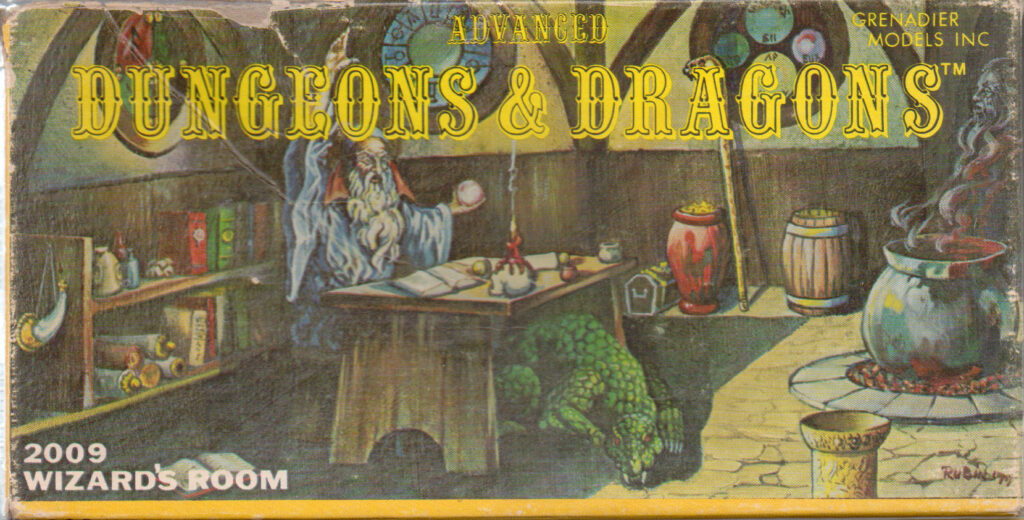
#5 – The Wizard’s Room. Cover art for the Grenadier miniatures. Wizard’s room I think was the very first set of miniatures I ever got… although it might have been the hirelings box… hazy memory right now. I still have them all. It was art that went beyond the cover. There was actual sculpture in the box that YOU could paint. I wanted any and all that I could get from that series. If I saw the yellow edge of that box in any hobby shop I was going to see what it was and most likely try to buy it.
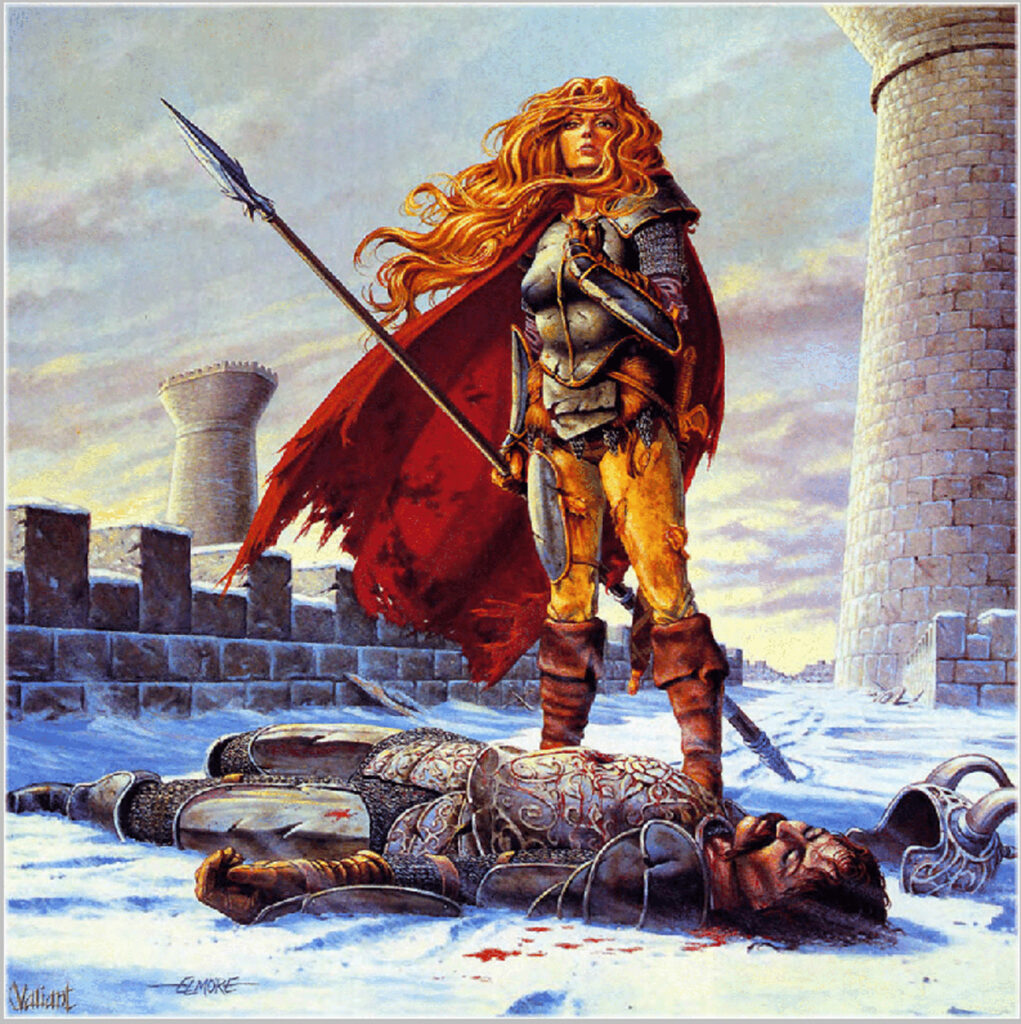
#6 – Draonlance Art. I could totally put any in here, but I’m going to pick just one. “The Death of Sturm” stunned me. It was character death in a novel. It was art that showed characters took damange and there were consequences to choices made. This is my favorite, but Dragonlance is a total “pick ’em” set. Larry Elmore’s art is amazing. Go look up any of it. Full stop.
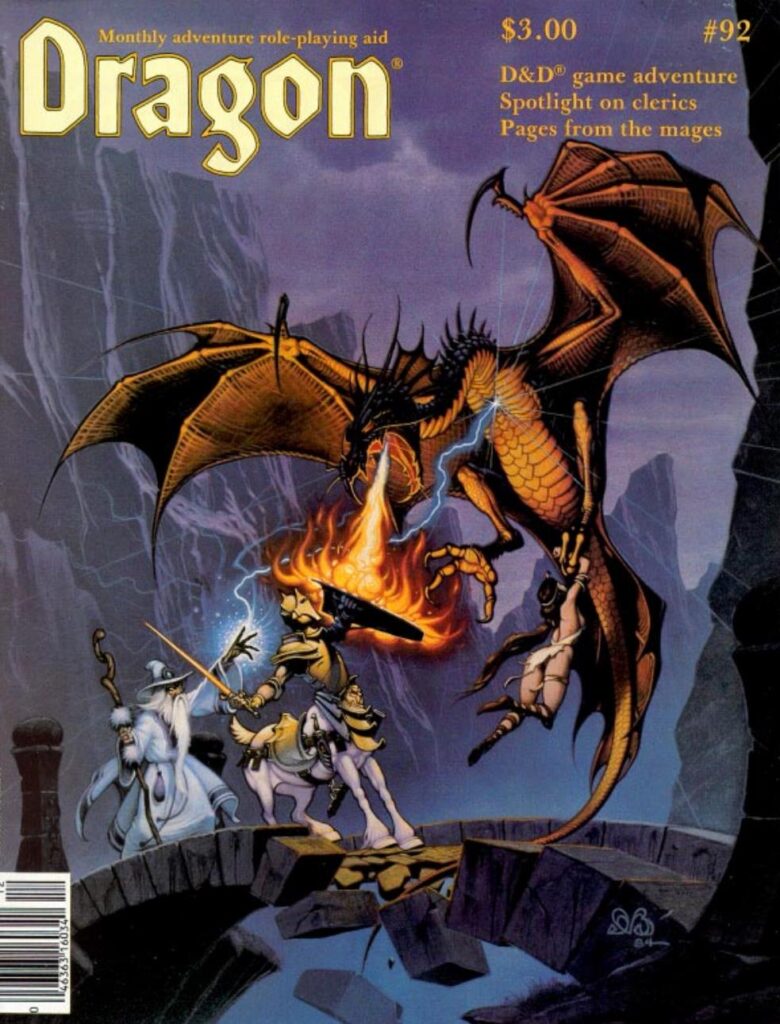
#7 – Dragon Magazine issue #92. Dragon, maiden, wizard. Spells, danger and the knight wasn’t just any knight, he was a centaur. I was all over this. It was such a popular cover that Ral Partha made a miniature of that cover. I still don’t have the nerve to paint it because I’m afraid I can’t live up to that cover.
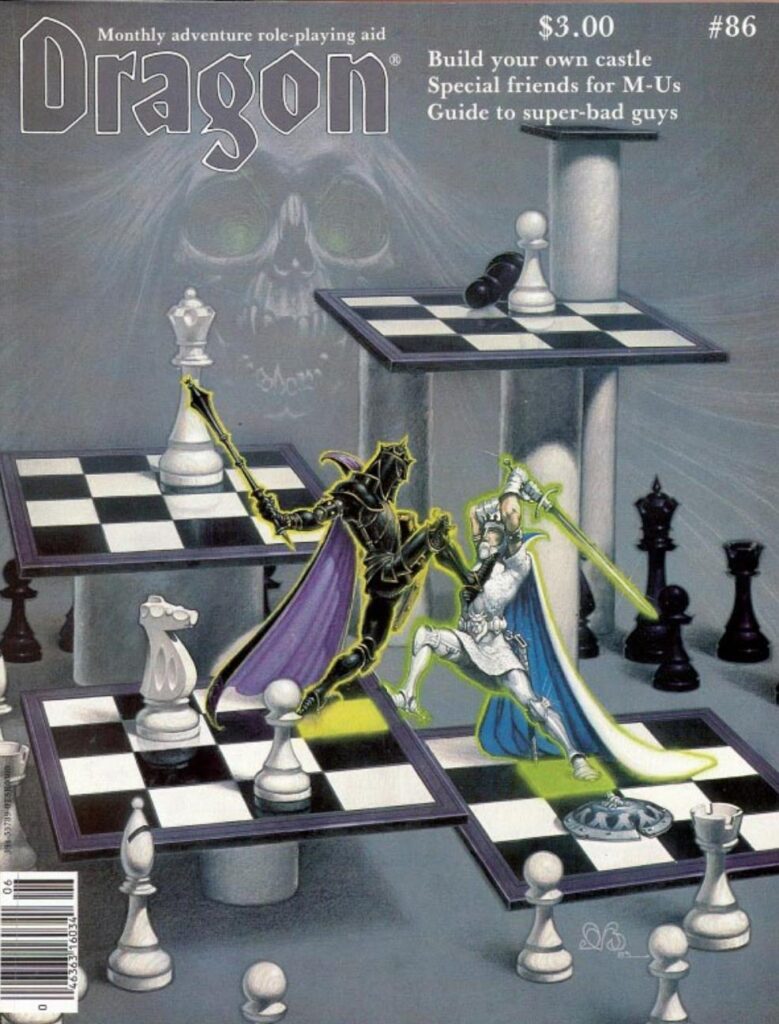
#8 – Dragon Magazine issue #86 “Stalemate”. Glowing multi-level chess warriors with some crazy lich in the background? Any cover from the “chess” series was amazing, but this one really worked for me. I tried to emulate that glowing effect in my own art (unsuccessfully) for a really long time. (I didn’t realize how many amazing covers this artist did, nor how much I really admire his art. Check out this stuff here: Dragon Covers )
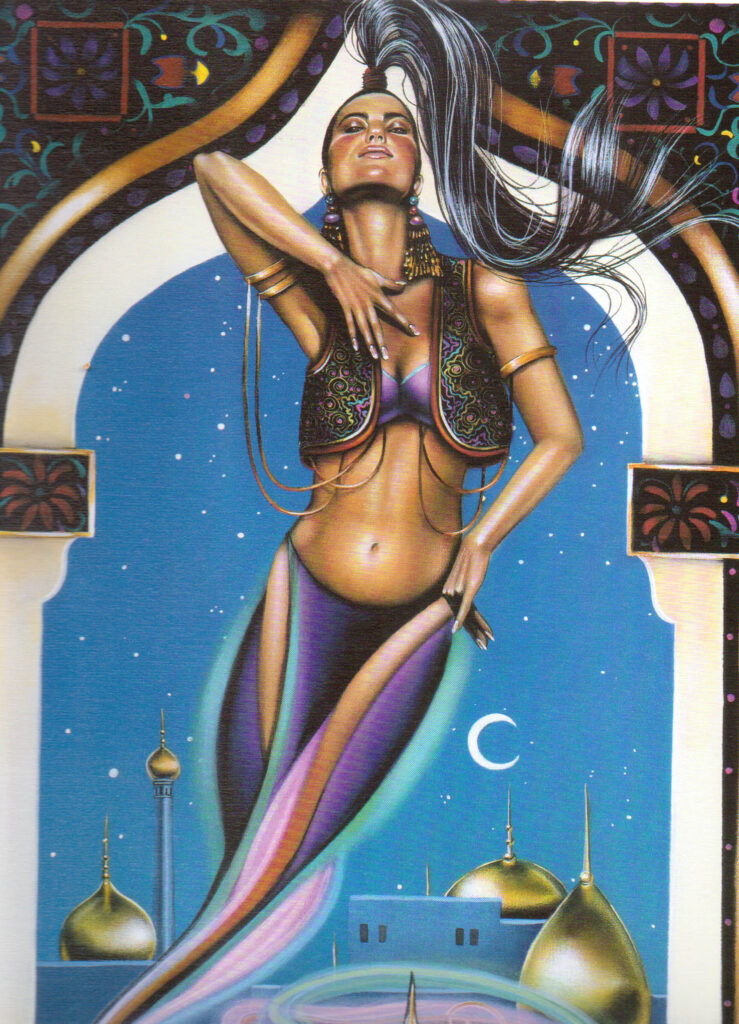
#9 – Al Quadim (I can’t figure out the name of the painting). I’m picking this piece as a representative of the whole line. This was a limited run, not an ongoing set of world building pieces. It had an exotic look and the bonus of laying out (via the Secretes of the Lamp supplement) the fabled City of Brass as shown on the 1st ed. DMG. There was so much to love here. I wish I could remember how I came to lay hands on a packet of promotional art – but these pieces have been in my collection since the very early 90s and they are fantastic.
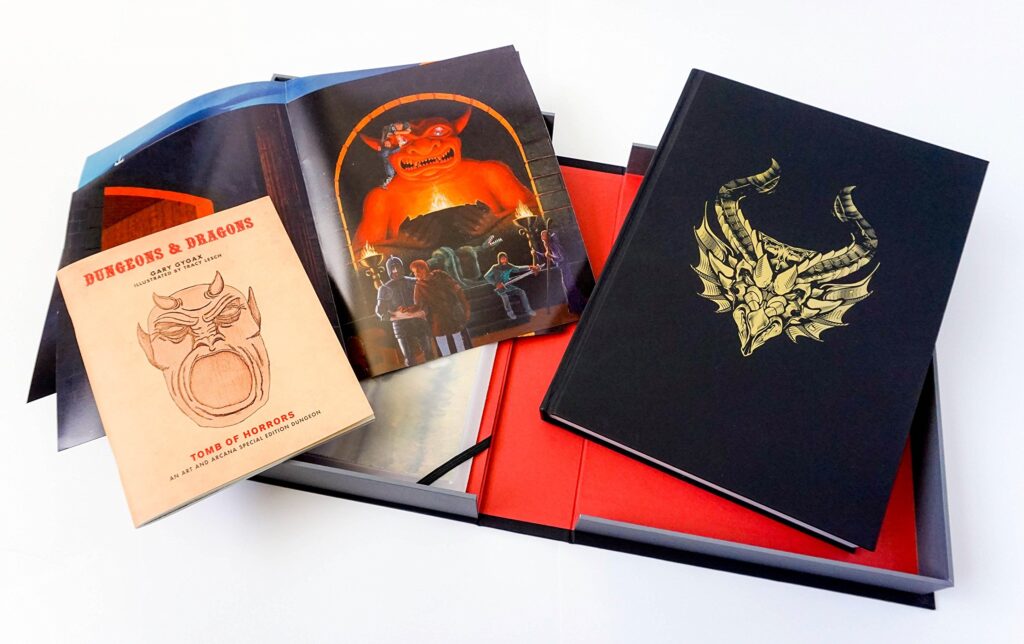
#10 – Dungeons & Dragons Art & Arcana: A Visual History. I suspect that some people will consider this “cheating” as many consider two dimensional paintings to be “art” but I disagree. This magnificent book is over four hundred pages of glory. My lovely wife got me the special edition box set with extra art included. It covers everything I’ve talked about here and so much more. There are pictures showing the entire line of handbooks from the earliest all the way up to 5th edition. There are old print ads, module maps and photos from the earliest days. I am happy this was made and delighted that I was able to get my hands on one.
There is so much art that ten pieces really can’t cover it all. Art and D&D are intertwined at the very core of what the game is. Imagination with a little something to spark it. Nudge your brain with a bit of a sketch or blow it away with some of the masterful works of these dedicated artists. I’m amazed at the variety of art that exists out there now and I intend to keep looking for it for the foreseeable future.
Spell Effects
I have a lot of actual work to do. I have 2 deadlines for edits that I need to hand in and some website work I need to do to get my site here cleaned up a little. Add a couple of professional touches that I am missing. I just wasn’t feeling it today. As happens so very frequently of late, I couldn’t sleep. My body is still in rebellion about something with aches, pains, and lots of other unpleasantries. So when I finished my second cup of coffee this morning I decided that some crafting was in order. Take on a small project, finish something and see if that would help.
My project of choice today was creating area of effect / spell effects for my D&D game. I picked a handful of spells and set about trying to make them in a form that we can just drop on my shiny new dungeon tiles next time we get to play.
Sculpting things with hot glue is an art form. It takes practice. I gathered up the stuff I needed and laid things out. The spells I decided to create for were web, Evard’s black tentacles, entangle, flaming sphere and wall of fire. I’d seen a video talking about how to go about making most of these before and they felt like things I could handle.
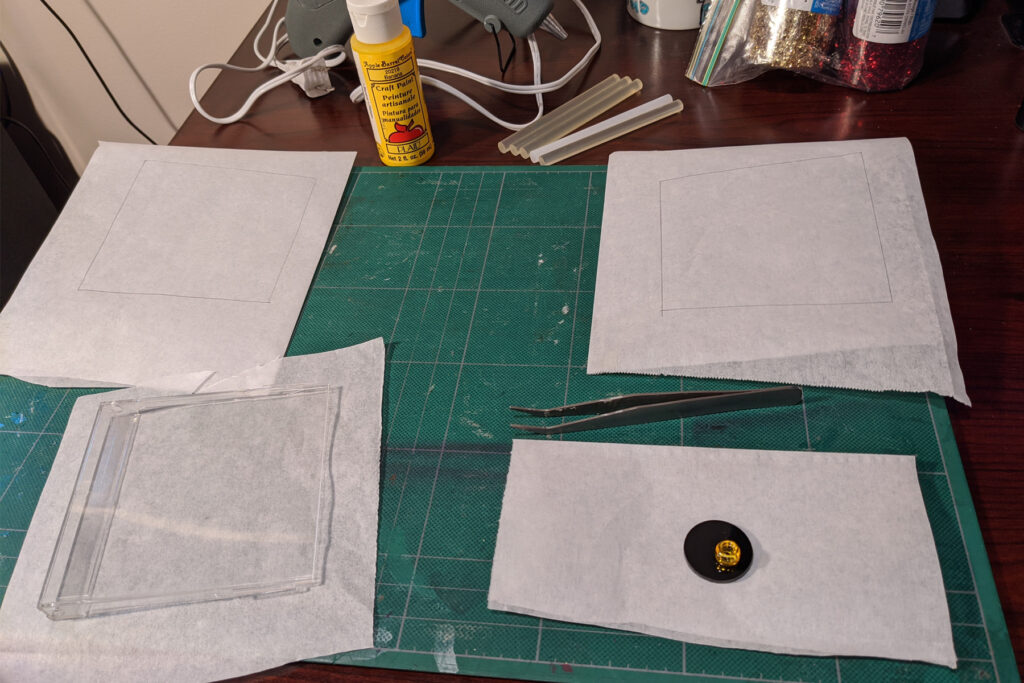
I hadn’t seen the wall of fire before. I’d seen a magic circle spell effect. The concept was the same and, as luck would have it I found this old, flat computer disk case in the bits box. I figured I’d pull it in half and each half would be it’s own wall. I popped on some safety glasses and went after the one side with my craft snippers. Safety glasses were a very good idea, trying to snip parts out of brittle plastic… not so much. After completely destroying one half of the box I decided that minimal changes to the other side was the way to go. I liked the fact that is has a square edge that will help it stand without some kind of crazy extra base addition.
I also had this thought about the flaming sphere. I was going to use a miniature base and start with a clear pony bead. I also planned to sprinkle a little bit of glitter into the glue as it was cooling. I figure that each of these things is a magic spell effect and a little glitter wouldn’t hurt. I thought I could start with a little bit of glue in the center of the base, pop the bead on there then start working my “sphere” outward from there. As it turns out, gravity was not my friend here. It made everything droopy and very non-sphere like. I changed tactics. I laid out a flat set of flames on the parchment paper and decided to curl that around the round mini base. The effect would be less “sphere” but it would still give the idea. I went with it.
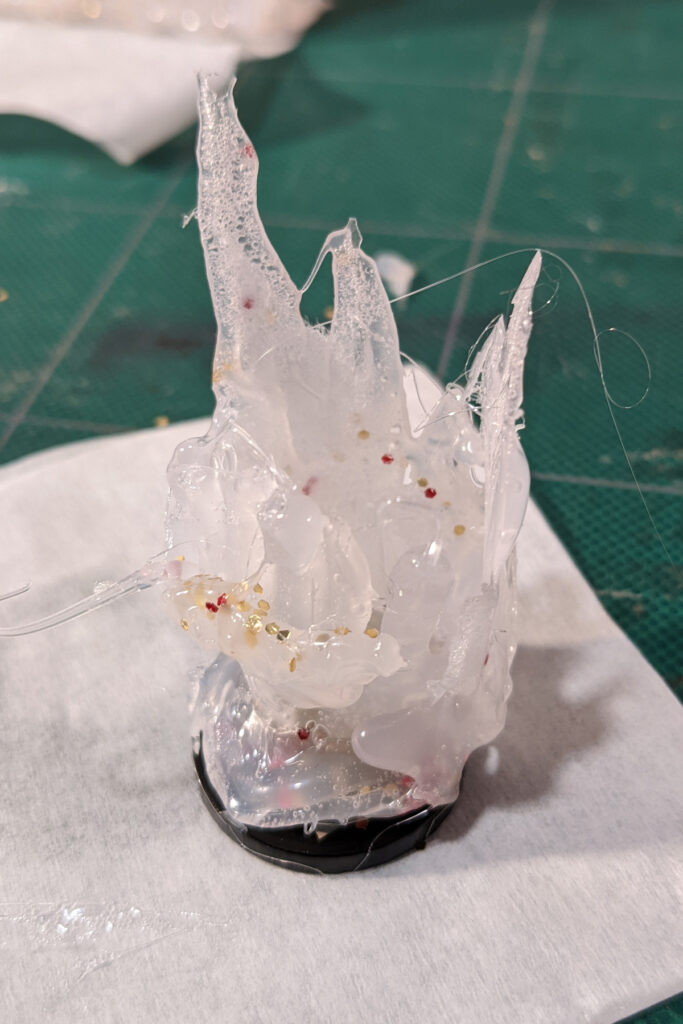
Forged ahead and started laying out the squares for the area effect things like web, tentacles and entangle. Normally parchment paper is really great for not sticking to the hot glue. This time for some reason, when I laid out my squares the paper just would not let go of the glue. I did what I could and pulled them all apart once they were dry. Moving from piece to piece while waiting for things to dry was a big help. This is a definite bonus to multitasking.
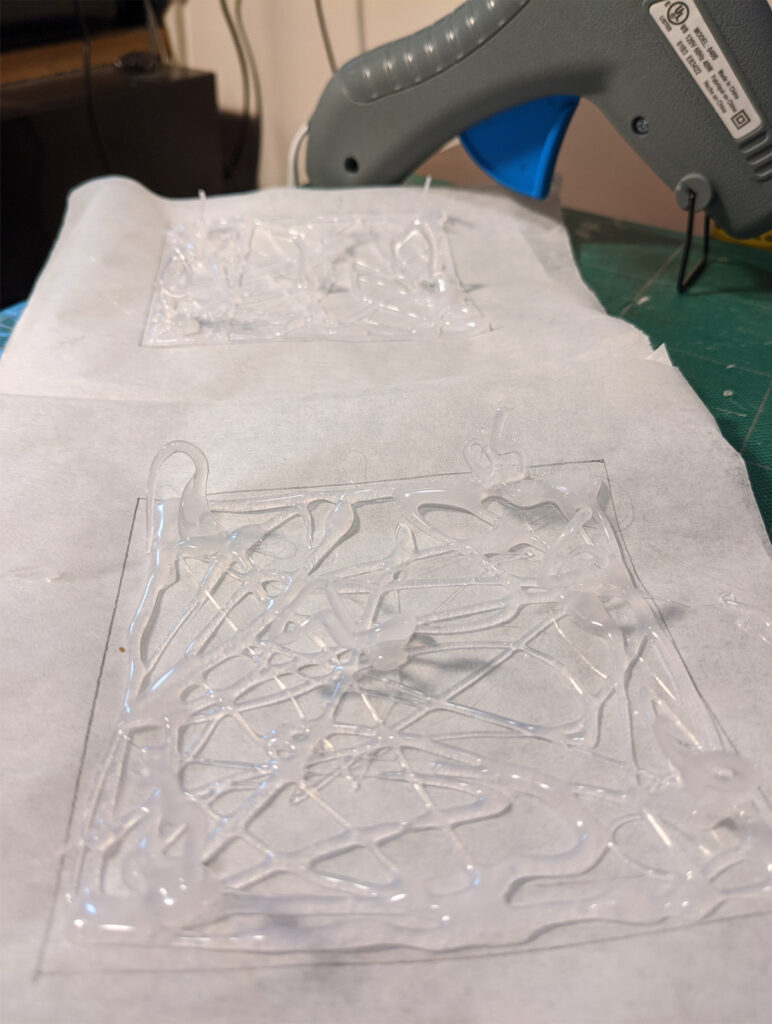
I gave a little bit extra to each of my squares. Some of it worked, some of it really didn’t. I used glow in the dark paint under the entangle spell. I added a little green glitter in with the flocking. I tried to get one or two extra bits of vine to stick and stay. The glow works where you can see it, if it’s dark enough. The flocking doesn’t look as great as I want it to and the vines just keep flopping off no matter what glue I use. I spray finished the whole thing and I’m just going to hope for the best. I added a little webbing from our Halloween decorations to my area effect for the web spell. I only painted the tentacles… and they seem to have turned out the best.
Painting the wall of flame and the flaming sphere worked out pretty well I think – and the wet palette actually is a super cool way to handle paints. I now understand why so many folks talk it up. I needed to take a break in the middle of these projects and when I got back all the pain was just as if I hadn’t left at all. I’ll be looking to the wet palette from now on.
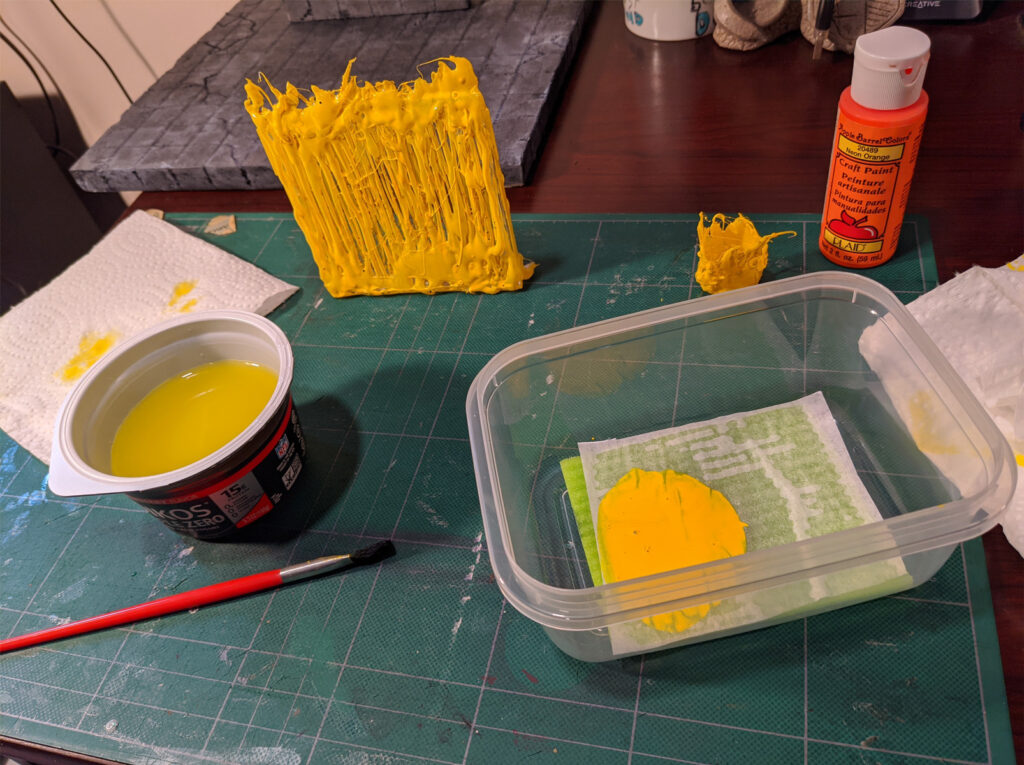
I struggled with various parts of each of these projects. The biggest issue I have still, is patience. I’m working very hard at getting better with this. Paint needs time to dry. Glue needs time to dry. Hot glue needs time to dry of you’ll burn your damn finger… again. Sometimes the effect you think will be great doesn’t work out that way. It’s a learning process. I’m looking forward to doing a lot more learning on these sorts of projects moving forward.
Here are some of the finished looks:
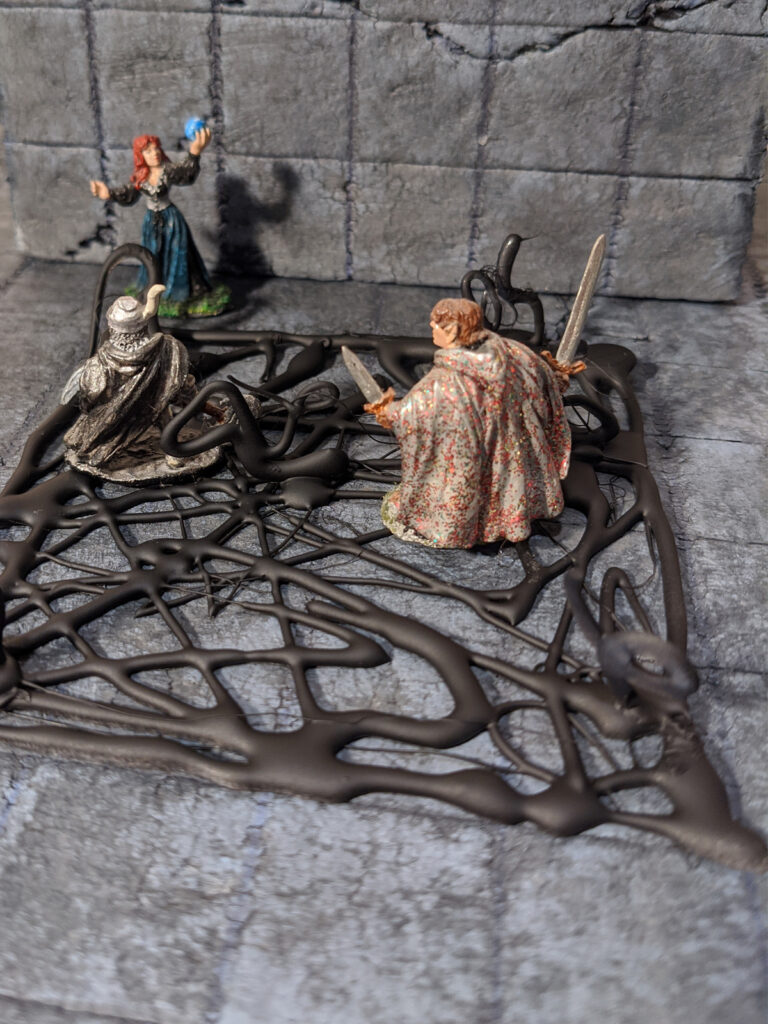
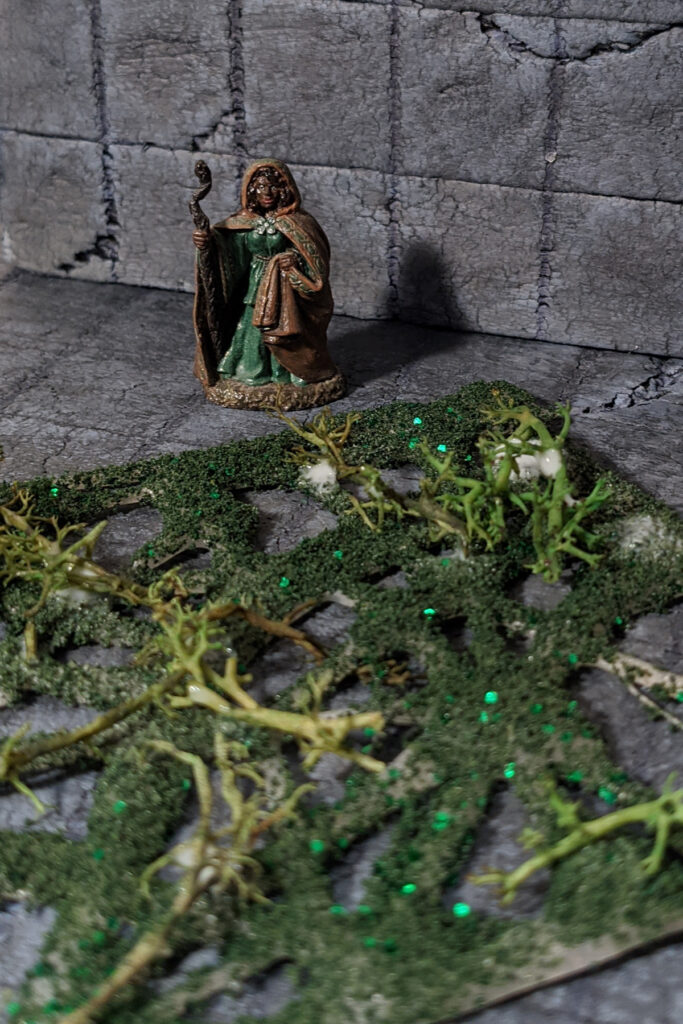
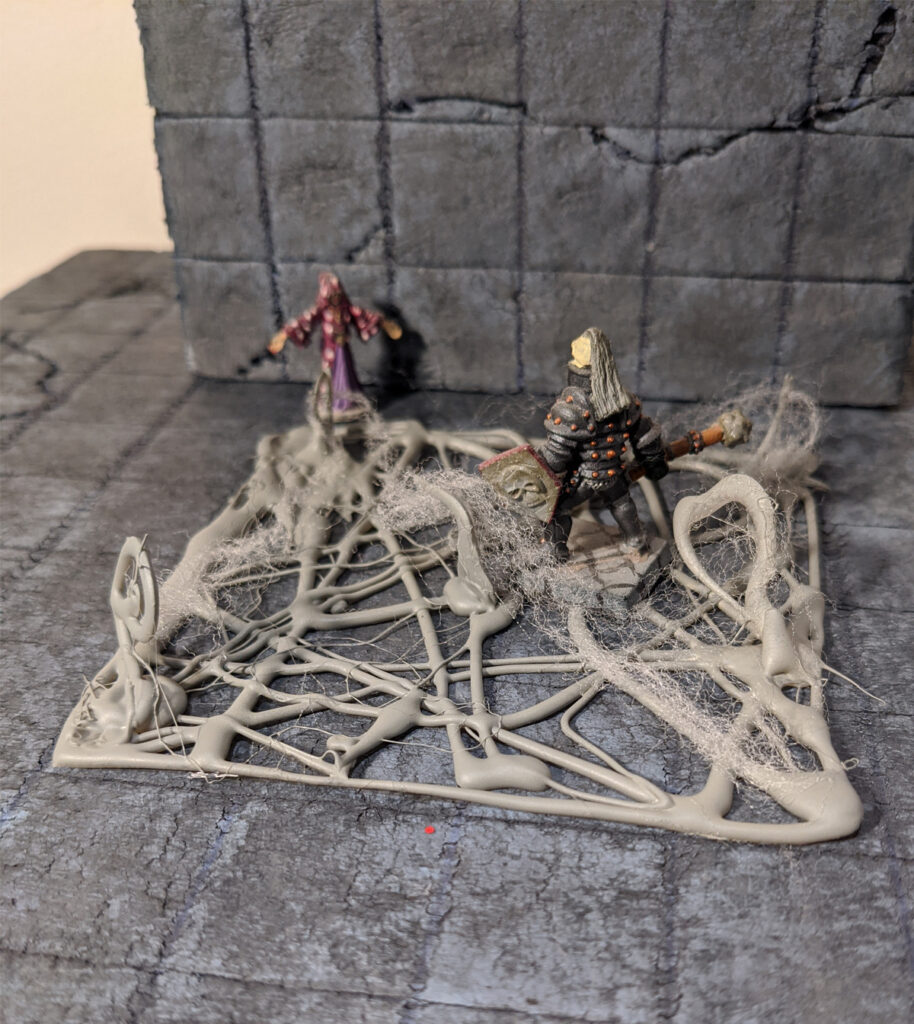
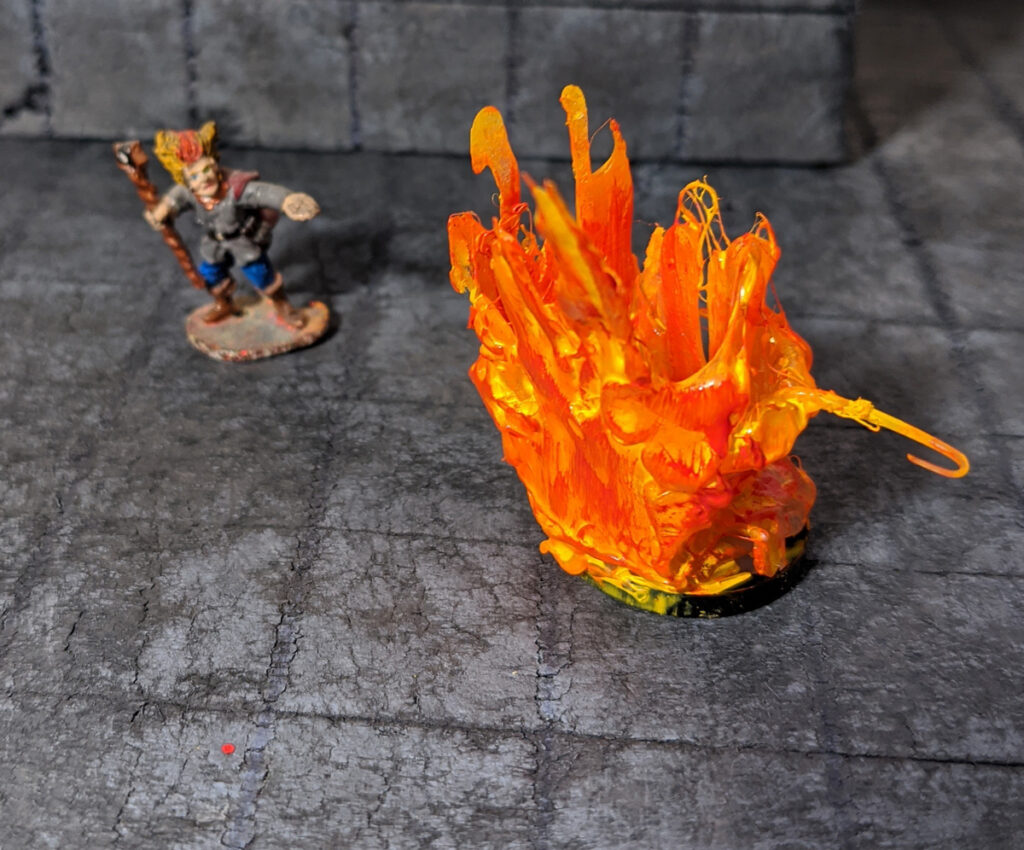
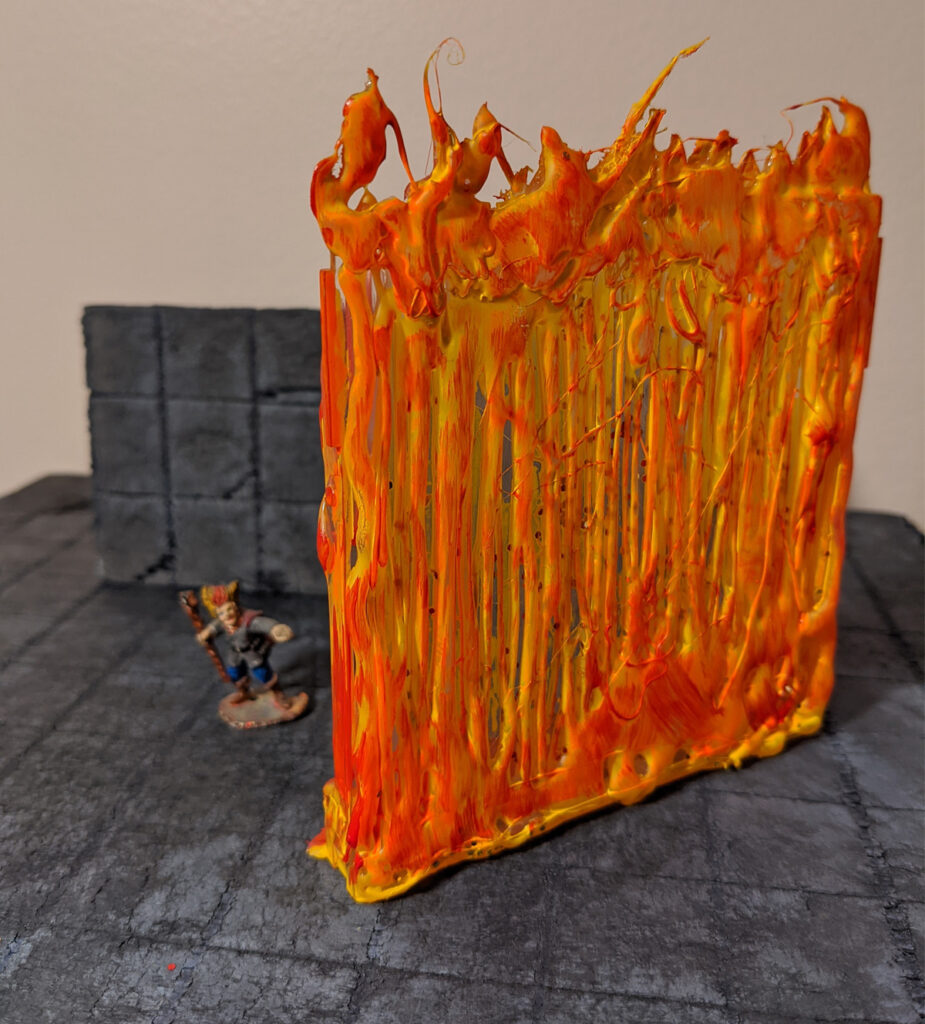
Another Attack of Opportunity!
I am delighted to share another video where I get to chat with Jon about D&D. This time we’re covering the top 5 novels that are fuel for your imagination – inspiring to your game. It was a fun conversation. I really look forward to our next chance to chat.
IF you don’t have the 50 minutes or so to watch, or if you’re at all interested I have put the notes I made up before we shot the video below here:
Top 5 fantasy books to read for inspiration (and why…)
I thought this was a great subject for a lot of reasons. First and foremost, reading anything is important. The further you reach, the greater the inspiration you’ll achieve. Reading a fantasy novel is what got me started along the path toward playing D&D.
Reading fantasy is a great way to pick up ideas, stretch your characters, expand your game world, learn new things about the real world AND sharing what you’ve read with others is a great way to connect with friends. There’s a lot of good that comes from digging into a book.
Why five? Because if we didn’t put a limit on this, the list would be boundless. There are hundreds of fantasy titles out there. You absolutely can find something you want to read. It will definitely help your game, but we don’t want to turn this into a book-cast.
This was not an easy list to compile. Not for lack of choices, but the shear number of things to pick through!
I’m going to eliminate 2 series right off the bat.
First – The Hobbit (and by association the LOTR trilogy). This is a tried and true “go to” for fantasy. It’s the starting point for so much that I don’t know how to take a fresh look at it. IF by some chance you’ve never read any Tolkien, it’s the basis for a huge amount of what we’re talking about.
Second – I’m not going to pander here. Any novel by our esteemed host is great inspiration for fantasy AND I absolutely recommend Blood and Iron for a setting that is not a traditional pseudo medieval fantasy look. I just think that “advertising” wasn’t necessarily the right way to go.
So – top 5 to read for inspiration – and why!
#1 – Throne of the Crescent Moon by Saladin Ahmed. (DAW books, 2012)
This is a great book. Above and beyond that, the inspiration part is in the use of a non-traditional hero character, a middle-eastern background, a murder mystery AND considerations of religion (like we talked about in our last visit).
If you’re doing an adventure involving genies, shifting sands, flying carpets, anything along those lines this is a book you need to get!
#2 – The Misenchanted Sword by Lawrence Watt Evans (DEL REY 1985)
Empires at war. Wizards, warriors, miscast spells and curses. IF you want to see the sort of variety you can have with some of the traditional characters in a D&D setting this is a great one. This is great if you want to teach your players to be careful what they ask for!
#3 – Thieves World edited by Robert Asprin (ACE 1978)
Adventures featuring a party of sneaks, rouges, assassins and other double dealing sorts can be a huge amount of fun. The thieves’ world series is shared world. It’s the same setting with shared characters over a series of short stories. There is a lot to be gleaned from these pages AND there are stories by some of the fantasy greats in there (Poul Anderson, Joe Haldeman, Robert Asprin…)
#4 – His Majesty’s Dragon by Naomi Novik (DEL REY 2006)
Dragons as weapons. Aerial combat. Navy ships. Kingdoms at war. This series really gives a lot of reasons to love it. Yes, it is outside the “traditional” swords and horses time frame. I don’t like to have pistols or cannons or modern weaponry mixed with my D&D campaign, but this book has a lot to get the creative juices flowing. Absolutely worth the read, even if you’re not using it for D&D.
#5 – The Way of Kings by Brandon Sanderson (TOR 2010)
Massive, immersive, epic fantasy. Knights, wars, magic and myths all mixed together in a fat, meaty book. Ballpark 1200 pages. This has rich, detailed views into a fantasy world that any gamer or game master should be reading (and there’s a lot to read!) Sanderson’s style is easy to read and the pages really melt away – do not let the size of the book intimidate you!
Tiling
When I was a kid playing Dungeons & Dragons there weren’t many options when looking for parts to enhance your game. The hobby was relatively new and the market was just ramping up. You may be thinking, “here we go, another things were better back in the day statement”. Not so. I’m actually stunned, amazed and really happy about where things are for D&D and associated parts of the hobby right now.
Some lucky few of us as kids were able to work for or add to the Christmas list official D&D miniatures. I’ve managed to hang on to those, but I no longer have any of the other things we used to supplement our game. One of the things we used to do was carve up any corrugated cardboard we could lay out hands on and cut them up into various combinations of squares. These flat ’tiles’ became what we used to represent the fabled 10′ x 10′ stone corridor that has become synonymous with classic dungeon crawls. I clearly remember the shoe box of cardboard I had filled with various combinations of corridor or room that could be laid out to show the ‘surroundings’ of the miniatures we were using. The imagination assistance worked really well.
Fast forward to today. There are multiple companies out there now selling every sort of miniature pieces or parts for dungeon masters to layout and confound players with. The pure art of these pieces really is exceptional.

It is also expensive. Paying the artists is important, but frequently WAY out of budget range.
Happily, the internet has also provided a way to connect with other people that are just as excited about creating these worlds as I am. There are literally thousands of folks out there coming up with new and imaginative ways to use various bits and pieces from around the house to create these worlds on a budget. I started posting a little while back about my journey back into this, and I’ve gone back to the very basics.
I made up some dungeon tiles.
It’s a very beginner level project. I saw a fellow crafter post something wondering about being proud of simple things, like these beginner projects. One of the most challenging things I’ve found about digging back into this hobby is learning to be patient and go through the various steps toward learning and experience. You don’t get to be a pro on day one. Stack up the lessons… and the dungeon tiles.
I started off with 1/2” extruded polystyrene insulation board (XPS) and carved up a bunch of shapes that would be my new set of tiles. I did all of this with a metal carpenters square, a pen and a box cutter. No high end, out of the budget stuff here. After carving all those bits up, I understand why crafters go after hot wire cutters and other expensive tools. This was labor intensive. I found that even on my best cuts, I wasn’t necessarily square or plumb. I forged ahead. These were meant to be faux stone after all. Anything carved by hand would have imperfections and odd edges.
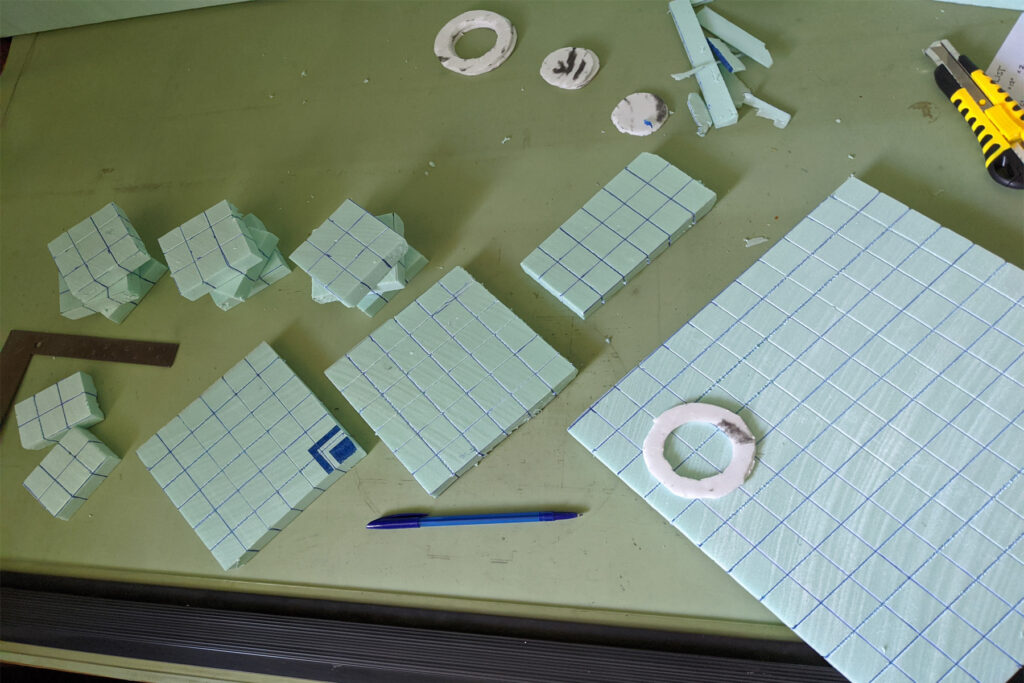
Once all the parts were cut, I laid out a 1” x 1” grid on all the tiles. This is the size of a large number of standard miniature bases and provides a convenient method for estimating distances at scale. I also added in a number of imperfections using the ball point pen. The idea was to gouge the foam. This would allow paint to get into the cracks and show the variations when painted. When I was painting I discovered that I probably needed to apply more pressure when creating my textures and adding cracks. I don’t think I went deep enough in many cases, so the paint mostly filled some of the cracks I made. As a YouTube crafter I follow said, “Crack to taste”. I did. I’ll do better next time.
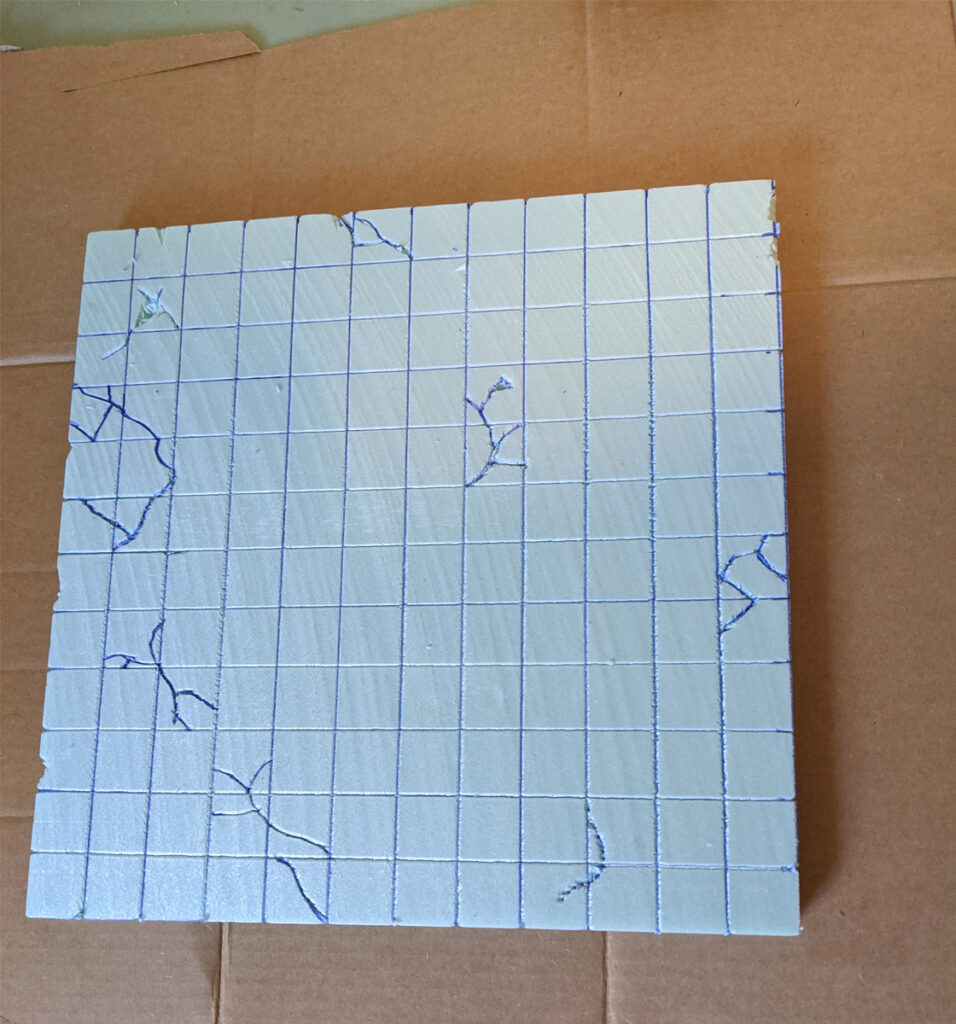
Once all the parts were set it was time to paint. It’s been a long time since I attempted to judge how much paint I might need in order to cover various miniature parts. I managed not to waste too much in my multiple coats. Black was first. I watered down a little bit of straight up black craft paint and covered them all. This would show up as deeper shadows whenever the rest of the paint was applied and didn’t seep down into all the cracks. Just had to wait for it to dry.
Once that was dry, it was on to a gray coat. This gray was applied pretty heavily. I was afraid that I had over done it when I finished with the gray. Some of the cracks had filled in. It was hard to see the texture. I wasn’t super happy, but I was this far along, I just needed to keep rolling. And wait for it to dry… again.
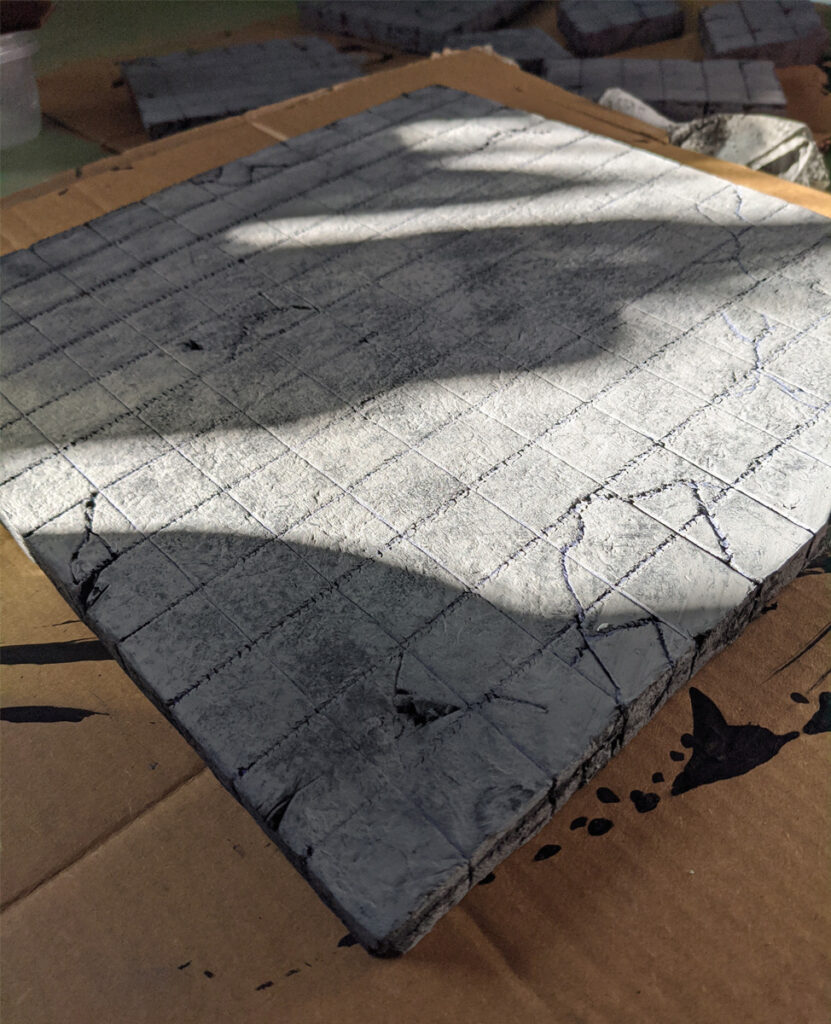
Next up was a dry brush over the high points. I misjudged the amount of paint a couple of times and my brush was not nearly as ‘dry’ as it was supposed to be. I used some paper towel and dabbed the excess back off when I could. I mixed a light (dolphin) gray along with a color called blue stoneware. It gave things a bit of a blueish tint, but that’s OK. It was what I was going for.
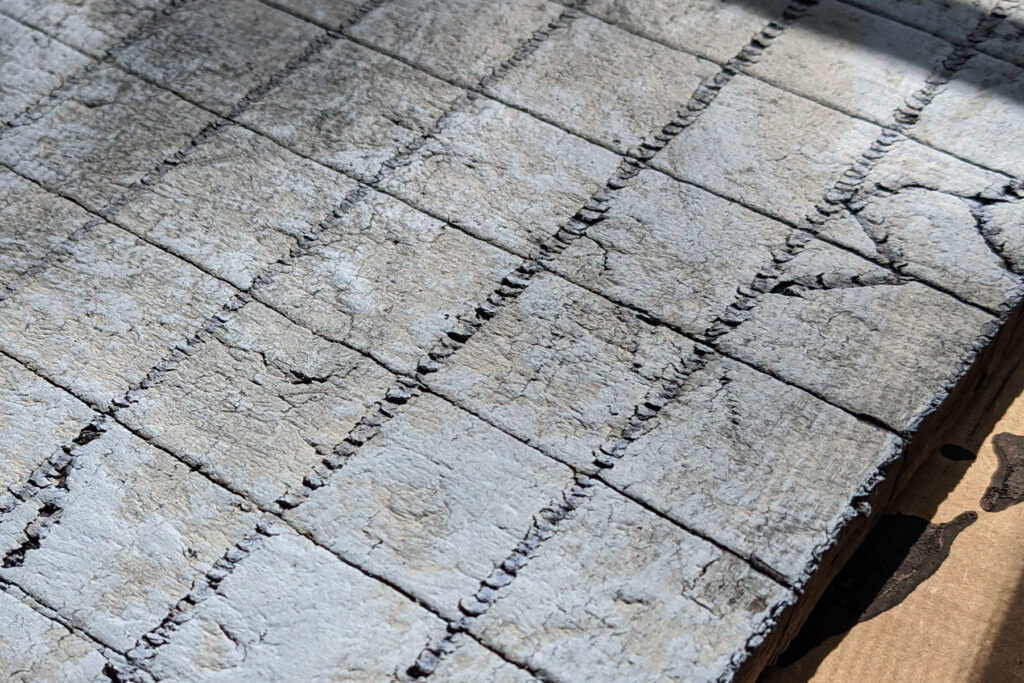
Just had to wait for things to dry… again.
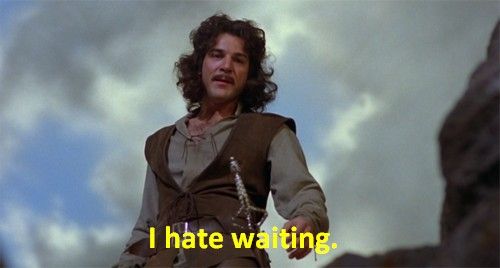
Once that bit was done, it was on to the wash. Back to black, but super watered down. I forgot to add in any sort of green or brown to add a feel of “grime” to this part, but I was just happy to be moving on. Looking back, I might have wanted to give each step a little more thought. As I said above, nobody’s a pro on day one.
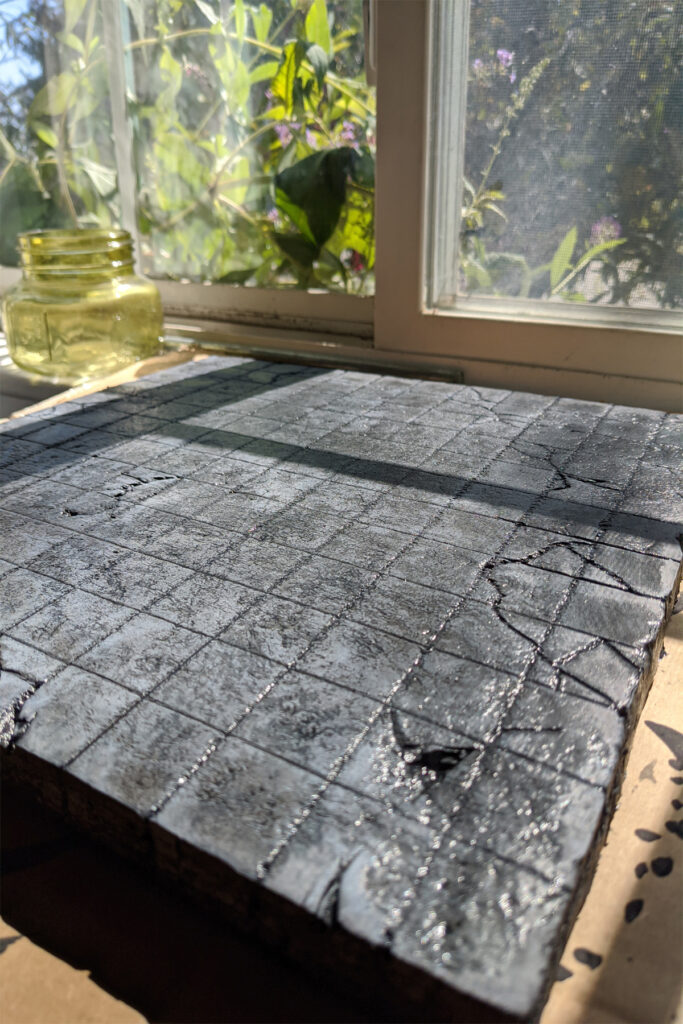
As things turned out, I’m a lot happier with them after all the steps were finished. So now it’s just a matter of sealing things up with a glue wash and stacking these up. Ready for my next gaming session! I’m calling this a success and I’m already looking forward to making more stuff.
Have you made anything lately?
Attack of Opportunity
Because so many of you have heard me lament all the free time I have on my hands (Ha!) I went and got into something else.
My buddy Jon has a YouTube channel and produces a show about Dungeons and Dragons called “Attacks of Opportunity”. Guess who he was kind enough to allow to be a guest on the show?
That’s right – I’m stepping out of my comfort zone and speaking very publicly about my lifetime hobby. I’m a gamer and have been for a long time. Dungeons and Dragons has been my game of choice as long as I can remember. I even remember talking my grandfather into playing at some point when I was a kid. I had passion.
Turns out, I still have that passion it has just been tempered over the years.
I’m really glad that I got the chance to be part of the production. It was a tough subject to start with (as mentioned in the video) but it was one that frequently needs attention. I have a lot of ideas on stuff to talk about when it comes to gaming and D&D particularly. I’m hoping to have a chance to be part of the channel again.
Here’s the video:
What sort of topic would you like to talk about? Is there a question that’s been hanging around out there that you wanted somebody to address? I’d like to hear it!
It’s how old?
This post could have also been titled, The past, exclusion, anachronism and genre. It’s a conversation that has come up more than once with others and in more than one context, so I thought I’d try to lay out some thoughts to get them in order here.
The past and exclusion:
I’ve been involved in genre stuff for a long time. OK, a long time for me but not long enough for others. Even as somebody who’s supposed to be the perfect person to ‘fit in’ at 50, straight and white, I find that I still don’t fit within certain groups in the science fiction landscape. This came up again after the most recent Hugo ceremony where a famous author apparently made a speech that excluded wide swaths of folks and made a bunch more feel angry about how it was all presented. The term “microaggression” came up. For that I defer to somebody much more in the know – an author I would recommend you read when you get a chance! See his post about said microaggressions here.
That feeling, that nagging tiny comment that seems to slide off the chosen group but digs directly into your subconscious is something I deal with frequently. That probably sounds a bit odd, but it’s true. I often feel as though I’m just outside “the group” or that I’m part of the group in question, but only in my particular slice of it and don’t get into where everyone else is.
The microaggression part is in reference to science fiction authors. It is an odd club and one that has for a long time had some twisted form of gatekeeper. This is not the only place where I’ve felt as if I am the outsider. Running conventions has always been on that list too. Fandom in general if I’m being honest about it. That’s where the anachronism part comes in.
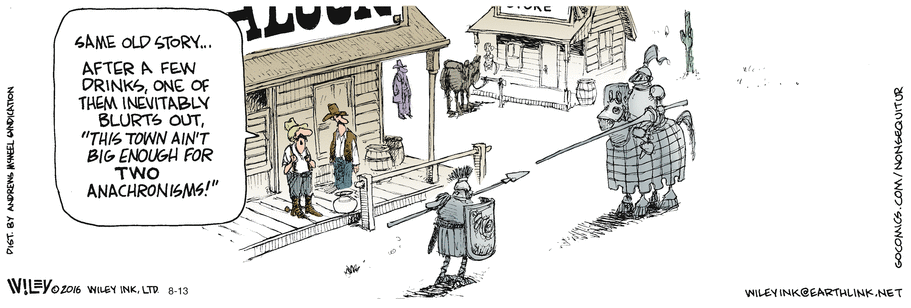
Anachronism:
There are a lot of times when I think I have landed just a decade or two later than I was supposed to. I seem to be interested in things that were really big, but really big in the past (recent or otherwise). The fanzine is an example of that. In the 70s and 80s the fanzine held a vital place in the genre landscape. Connections were made, thoughts were shared, and in some cases careers were launched. I’ve helped out with a fanzine for two decades now, but find that ours started about two decades too late for that “control group”. Even when I have reached out to those groups I’ve gotten no reply. WE were here long ago ~ you “newbie” are unwelcome here. It’s rarely said directly, but the feeling is certainly there. It’s something that truly bothers me about a genre that’s supposed to be so progressive (hint – it’s totally NOT).
That lead to another discussion about older works in science fiction. Do you really need to read the works of the people given grand master status? Should you pick up and push through something that was written thirty years before you were born? Maybe. Maybe not. Does your familiarity with these works, chosen by folks that believe they control who’s in and who’s out, matter? Other authors have taken on this topic and put forth decent opinions about it. I tend to like this take on the subject, but I don’t think it fully expresses where I am.
Genre:
I frequently enjoy any number of those old works. Reading the words of Ray Bradbury were amazing to me when I was a kid. He was truly gifted. His prose is smooth, evocative and moving. Sneaking out of the house to go to the local carnival is not a thing that any child I know today will relate to. Tattoos are not seen in quite the same context as when “Illustrated Man” was written. I like to dig into the history and see where so many amazing ideas came from. It gives context to so many things, as any study of history will… but that’s just it, they’re history. They are not entirely irrelevant, but their relevance is limited. Do they have the tug of nostalgia or the faint whiff of ‘this was big‘, of course they do. They were big and important or nobody would remember them. Movie makers have dug into many of those old works and adapted them to great success. None of them have had the cultural impact of a certain boy wizard, but even his influence has already started to change and fade. Things grow and change. It happens.
It has happened with gaming. My dearest lifetime hobby has undergone a vast change in the forty years that I have been playing it. Dungeons and Dragons is not what it used to be. Guess what? It shouldn’t be! If it had been static all this time it would have been relegated to the dust bin a long time ago. It has grown and changed and become something that looks a lot like what I have always loved, but is something new. Should I scoff or brush away people that don’t remember what it was like to have to poke chits out of a piece of cardboard because polyhedral dice were not a thing when I started? They haven’t “paid their dues” … that’s an amazing amount of bullshit all in a few simple words. Thing is, it’s an easy feeling to get. It’s easy to be resentful of people that didn’t go through challenges and to be protective of what you endured pain for.
The simplest answer is no. Whatever my feelings about genre fiction or role playing games might be, they should never be a limiting factor of how others enjoy them. Being the curmudgeonly old bastard yelling about kids and lawns is the fastest way to ensure that what you love dies. IF you’re driving people away from your hobby because they “don’t fit in”, first check your bias and privilege and second, you’re directly complicit in said death. Science fiction is supposed to be about the future. Fantasy gaming is supposed to involve your imagination and dreams. If you can’t see the future or evoke your imagination and are mired in the past, perhaps it’s best if you step aside. The best response, as far as I can tell, when somebody likes something new and shiny (that is entirely a remake of something from way back when particularly) is to say something like, “Oh, really? If you like that, I bet you’ll love this…”. The most important part of that whole statement being a welcoming and social attitude. Helping folks find more of what they love by aiming them at the things you’ve found that you love can be a fantastic way to make a personal connection and the absolute best way to get what you love to live on for a long time to come. I want science fiction and role playing games to be around for a long time to come. I hope I can share some history with you as we go.
